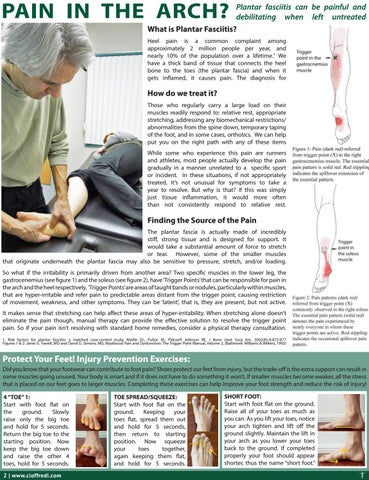PAIN IN THE ARCH?
Plantar fasciitis can be painful and debilitating when left untreated
What is Plantar Fasciitis? Heel pain is a common complaint among approximately 2 million people per year, and nearly 10% of the population over a lifetime.1 We have a thick band of tissue that connects the heel bone to the toes (the plantar fascia) and when it gets inflamed, it causes pain. The diagnosis for
How do we treat it? Those who regularly carry a large load on their muscles readily respond to: relative rest, appropriate stretching, addressing any biomechanical restrictions/ abnormalities from the spine down, temporary taping of the foot, and in some cases, orthotics. We can help put you on the right path with any of these items While some who experience this pain are runners and athletes, most people actually develop the pain gradually in a manner unrelated to a specific sport or incident. In these situations, if not appropriately treated, it’s not unusual for symptoms to take a year to resolve. But why is that? If this was simply just tissue inflammation, it would more often than not consistently respond to relative rest.
Finding the Source of the Pain The plantar fascia is actually made of incredibly stiff, strong tissue and is designed for support. It would take a substantial amount of force to stretch or tear. However, some of the smaller muscles that originate underneath the plantar fascia may also be sensitive to pressure, stretch, and/or loading. So what if the irritability is primarily driven from another area? Two specific muscles in the lower leg, the gastrocenemius (see figure 1) and the soleus (see figure 2), have ‘Trigger Points’ that can be responsible for pain in the arch and the heel respectively. ‘Trigger Points’ are areas of taught bands or nodules, particularly within muscles, that are hyper-irritable and refer pain to predictable areas distant from the trigger point, causing restriction of movement, weakness, and other symptoms. They can be ‘latent’, that is, they are present, but not active. It makes sense that stretching can help affect these areas of hyper-irritability. When stretching alone doesn’t eliminate the pain though, manual therapy can provide the effective solution to resolve the trigger point pain. So if your pain isn’t resolving with standard home remedies, consider a physical therapy consultation. 1. Risk factors for plantar fasciitis: a matched case-control study. Riddle DL, Pulisic M., PidcoeP, Johnson RE. J Bone Joint Surg Am. 2003;85-A:872-877 Figures 1 & 2: Janet G. Travell, MD and David G. Simons, MD, Myofascial Pain and Dysfunction: The Trigger Point Manual, Volume 2, (Baltimore: Williams & Wilkins, 1992)
Protect Your Feet! Injury Prevention Exercises: Did you know that your footwear can contribute to foot pain? Shoes protect our feet from injury, but the trade-off is the extra support can result in some muscles going unused. Your body is smart and if it does not have to do something it won’t. If smaller muscles become weaker, all the stress that is placed on our feet goes to larger muscles. Completing these exercises can help improve your foot strength and reduce the risk of injury! 4 “TOE” 1: Start with foot flat on the ground. Slowly raise only the big toe and hold for 5 seconds. Return the big toe to the starting position. Now keep the big toe down and raise the other 4 toes, hold for 5 seconds. 2 | www.cioffredi.com
TOE SPREAD/SQUEEZE: Start with foot flat on the ground. Keeping your toes flat, spread them out and hold for 5 seconds, then return to starting position. Now squeeze your toes together, again keeping them flat, and hold for 5 seconds.
SHORT FOOT: Start with foot flat on the ground. Raise all of your toes as much as you can. As you lift your toes, notice your arch tighten and lift off the ground slightly. Maintain the lift in your arch as you lower your toes back to the ground. If completed properly your foot should appear shorter, thus the name “short foot.”

















